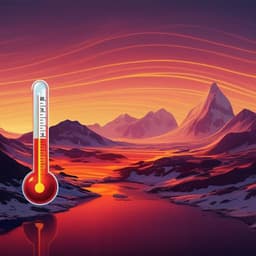
Earth Sciences
Dominant role of vertical air flows in the unprecedented warming on the Antarctic Peninsula in February 2020
M. Xu, L. Yu, et al.
Discover the astonishing atmospheric phenomenon that led to a record-high temperature of 18.3 °C at the Argentinian Esperanza Base in Antarctica. This groundbreaking research by Min Xu, Lejiang Yu, Kaixin Liang, Timo Vihma, Deniz Bozkurt, Xiaoming Hu, and Qinghua Yang uncovers the atmospheric circulation patterns and warm Pacific air masses behind this extreme event.
~3 min • Beginner • English
Introduction
The Antarctic Peninsula (AP), the northernmost part of Antarctica, has experienced notable temperature variability, with a significant warming trend from the 1950s to around 2000 and cooling since then. These temperature changes affect ecosystems, ice shelf and glacier mass balance, and thus global sea level. The AP’s orography divides climate between a milder, humid west coast and a cooler, more continental east coast. On the northwest side, warming has been linked to strengthened northerly flow associated with South Atlantic pressure increases and a deepened Amundsen Sea Low, often related to tropical Pacific SST anomalies via Rossby wave trains. On the northeast side, strong circumpolar westerlies during positive Southern Annular Mode favor dry, warm downslope foehn winds, which strongly influence warming. Esperanza Base (63.4°S, 57°W), on the northeastern tip and lee of ~1100 m terrain, shows summer warming trends and episodic extreme warm events (e.g., 17.5 °C on 24 March 2015 due to a foehn triggered by an atmospheric river). On 6 February 2020, Esperanza recorded 18.3 °C, the highest on the continent, coincident with record-high melt on Larsen C and prolonged above-freezing periods elsewhere on the AP. This study investigates how horizontal heat advection, vertical motion, and diabatic heating combined to produce the record 2020 temperature, and places the event in a multi-decadal context of extreme summer warm events.
Literature Review
Prior work documents long-term AP warming through late 20th century followed by recent cooling phases, with implications for ice shelves and ecosystems. Studies link northwest AP warming to circulation changes (South Atlantic pressure increases, Amundsen Sea Low deepening) and teleconnections from tropical Pacific SST anomalies. On the northeast AP, positive SAM strengthens circumpolar westerlies, promoting foehn winds that enhance warming and ice shelf melt (e.g., Larsen C). Earlier analyses reported significant summer temperature trends at Esperanza (e.g., ~0.29–0.4 °C per decade depending on period). Extreme events have been attributed to foehn dynamics sometimes triggered by atmospheric rivers (e.g., March 2015). The literature highlights the role of anticyclonic ridges and blocking patterns in transporting warm, moist air to the AP and the importance of foehn mechanisms in generating extreme warmth on the lee side.
Methodology
Observational data: Hourly surface observations (3-hourly available since 1973) of air temperature, wind speed and direction, and relative humidity at Esperanza from NOAA’s Integrated Surface Database (quality controlled). Reanalysis: ERA5 hourly fields with 0.25° resolution and 37 pressure levels (1000–1 hPa) were used for 2 m temperature, 10 m winds, mean sea level pressure, 500 hPa geopotential height and winds, 850 hPa temperature and geopotential height, and temperature, wind, vertical velocity at 925 and 975 hPa, plus surface pressure/geopotential. Synoptic analyses focused on 15 UTC each day around the event (2–8 Feb 2020), aligned with the 6 Feb peak temperature. Thermodynamic decomposition: The temperature tendency was partitioned using the thermodynamic equation into (1) horizontal advection computed from ERA5 winds and temperature gradients; (2) vertical motion effects including adiabatic heating and vertical advection using ERA5 vertical velocity and temperature lapse between 850 hPa and near-surface (2 m) to estimate ∂T/∂p at 975 hPa; and (3) diabatic heating consisting of shortwave/longwave radiative heating from the model’s lowest level deterministic forecast, latent heating estimated from ERA5 precipitation (1 mm h⁻¹ ≈ 1.5 K h⁻¹), and sensible heating estimated by assuming linear decay of sensible heat flux to the top of the boundary layer (using ERA5 sensible heat flux and boundary layer height). Spatial diagnostics included maps of the vertical term at 925 hPa and a vertical cross-section at ~63.5°S to assess foehn structure. Lagrangian analyses: HYSPLIT was used to compute 24 h and 10-day backward trajectories for air masses associated with extreme summer warm events (DJF) from Dec 1973 to Feb 2020 (with gaps in 1979, 2004, 2005). Extreme events were defined as days exceeding the 95th percentile of daily maximum temperature. Cluster analysis grouped trajectories into six clusters by minimizing within-cluster variance and maximizing between-cluster differences; mean trajectories and associated temperature statistics were analyzed. A Lagrangian heat budget quantified foehn components along a 24 h backward path, evaluating contributions from (i) isentropic drawdown, (ii) thermodynamic (latent heating/precipitation on windward side), (iii) sensible and radiative heating on lee side, and (iv) pressure gradient effects, using temperatures and (equivalent) potential temperature at three characteristic points (A, B, C) relative to the AP barrier. Integrated water vapor transport was examined to identify atmospheric rivers and compare the 2020 event with March 2015.
Key Findings
- On 6 Feb 2020 at 15 UTC, Esperanza’s 2 m air temperature peaked at 18.3 °C (highest ever on the Antarctic continent). From 06–15 UTC the same day, temperature rose from −0.7 °C to 18.3 °C in 9 h, with a peak warming rate of ~4 °C h⁻¹. A secondary peak of 17.3 °C occurred at 21 UTC. The warming coincided with wind speed increasing from ~1.5 to 19 m s⁻¹, southwesterly direction, and relative humidity dropping from ~90.5% to 22.6%.
- Synoptic setup featured a high-pressure ridge over 40°–100°W and a blocking high over the Drake Passage at 500 hPa, with low pressure over the southeastern Pacific. This anticyclonic anomaly (≈300 gpm at 500 hPa near Esperanza, ~2.5 SD above climatology) disrupted the circumpolar westerlies, deepened and expanded the Amundsen Sea Low northward, and transported warm marine air from the Pacific toward the Bellingshausen Sea and AP.
- Thermodynamic decomposition (at 975 hPa near 63.5°S, 57°W) showed the warming on 6 Feb was dominated by the vertical motion term (adiabatic warming and vertical advection). Diabatic heating contributed positively but was largely offset by negative horizontal advection, indicating southwest winds advected relatively colder air locally while warm air affected the Bellingshausen Sea.
- Spatial structure at 925 hPa showed strong vertical-term warming rates on the northeastern AP near Esperanza, with limited impact on the west side (e.g., O’Higgins at similar latitude recorded only 1.7 °C), consistent with local orographic foehn effects. Cross-sections revealed accelerated downslope flow on the lee side and isentropic drawdown.
- Lagrangian foehn heat budget (24 h backward trajectory) estimated total foehn warming of ~4 K, with contributions: +0.6 K from isentropic drawdown, −0.6 K from thermodynamic (latent heating/precipitation) mechanism, +5.7 K from sensible and radiative heating on the lee side, and −1.7 K from pressure gradient effects. Thus, sensible and radiative heating dominated the foehn warming during this event.
- An atmospheric river was present on 6 Feb 2020 but weaker than in March 2015; it did not drive strong latent heating, consistent with the small/negative thermodynamic contribution.
- Climatology (1973–2020 DJF): 196 extreme warm events grouped into six trajectory clusters. About 89% of air masses originated 500–1500 m above the Pacific, crossing Drake Passage. Cluster 5 (≈22% of cases), including the Feb 2020 event, followed a relatively short, recurved route from the Pacific and exhibited the highest upper-quartile temperatures and the maximum outlier (18.3 °C). Cluster 6 (≈11%) differed, associated with an anticyclonic circulation over the NW Weddell Sea. Composite 500 hPa anomalies for Cluster 5 resembled the Feb 2020 pattern with a positive height anomaly over the Drake Passage.
- Overall, most extreme warm events at Esperanza are linked to marine air inflow from the Pacific and development of a tropospheric ridge/blocking over the Drake Passage.
Discussion
The study set out to determine how horizontal advection, vertical motion, and diabatic processes combined to produce the February 2020 record temperature at Esperanza and how representative the event is of summer extremes. Results show that local-scale vertical processes associated with foehn flows dominated the rapid warming, outweighing horizontal heat advection that was actually negative at the station during peak warming. The synoptic anticyclonic ridge and blocking high over the Drake Passage enabled transport of warm, moist marine air toward the AP; however, upon encountering the AP orography, the airflow produced strong downslope warming. The Lagrangian heat budget highlights that sensible and radiative heating on the lee side was the principal driver, with minimal positive role for isentropic drawdown and negative contributions from latent heating and pressure gradient during this event. Climatological trajectory clustering places the 2020 event within a common pattern (Cluster 5) characterized by short-path Pacific inflow and a 500 hPa positive height anomaly over the Drake Passage. These findings reinforce the importance of foehn dynamics and blocking highs in producing extreme warmth and related surface melt on the northeastern AP, informing understanding of AP climate variability and ice shelf vulnerability.
Conclusion
A new continental temperature record of 18.3 °C was observed at Esperanza on 6 Feb 2020. The event arose from a favorable synoptic configuration—a high-pressure ridge and blocking high over the Drake Passage advecting warm marine air—combined with strong local foehn processes. Quantitative decomposition shows vertical motion (downslope/adiabatic warming) dominated the temperature increase, with diabatic heating contributing positively and horizontal advection being negative locally. A detailed Lagrangian heat budget indicates that sensible and radiative heating on the lee side were the main contributors to foehn warming, while latent heating and pressure-gradient effects were negative or minor. Climatologically, most summer extreme warm events at Esperanza originate from Pacific-sector air masses crossing Drake Passage and are associated with tropospheric ridging; the 2020 event fits this common cluster. Given Esperanza’s location on the leeward side of substantial topography and frequent influence of midlatitude systems, similar extreme temperatures may recur. Future work should employ higher-resolution numerical simulations to better resolve foehn dynamics, boundary-layer processes, and interactions with the ocean and cryosphere in the complex AP environment.
Limitations
The ERA5 reanalysis spatial resolution limits detailed representation of foehn dynamics and local boundary-layer processes near complex terrain, potentially under-resolving mechanisms and thermodynamic gradients at Esperanza. The thermodynamic decomposition relies on approximations (e.g., estimating ∂T/∂p from 850 hPa and 2 m temperatures; linear decay of sensible heat flux to boundary-layer top; latent heating estimated from precipitation rates). HYSPLIT trajectory and heat budget analyses depend on reanalysis-driven winds and thermodynamics and on idealized point selections (A, B, C). Observational data gaps exist for 1979, 2004, and 2005. Synoptic snapshots at 15 UTC were used to represent daily patterns, which may miss sub-daily variability.
Related Publications
Explore these studies to deepen your understanding of the subject.







